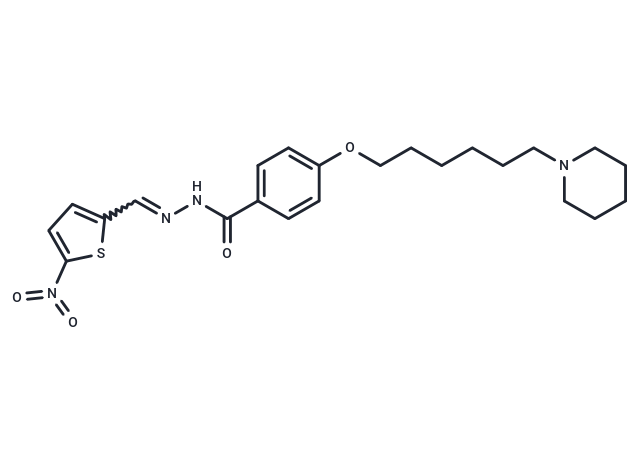Shopping Cart
Remove All Your shopping cart is currently empty
Your shopping cart is currently empty
TGFβ1-IN-2, a derivative of diarylacylhydrazones, effectively inhibits fibroblast activation and proliferation and holds potential for idiopathic pulmonary fibrosis (IPF) research [1].

| Pack Size | Price | USA Warehouse | Global Warehouse | Quantity |
|---|---|---|---|---|
| 1 mg | $167 | - | In Stock | |
| 5 mg | $407 | - | In Stock | |
| 10 mg | $496 | - | In Stock | |
| 25 mg | $663 | - | In Stock | |
| 50 mg | $826 | - | In Stock | |
| 100 mg | $1,050 | - | In Stock | |
| 200 mg | $1,380 | - | In Stock |
| Description | TGFβ1-IN-2, a derivative of diarylacylhydrazones, effectively inhibits fibroblast activation and proliferation and holds potential for idiopathic pulmonary fibrosis (IPF) research [1]. |
| In vitro | TGFβ1-IN-2 (compound 52) inhibits NIH-3T3 cells with an IC50 of 1.36 μM [1], and at 6 μM over 24 hours, it suppresses TGF-β1-induced overactivity in NIH-3T3 and A549 cells while inhibiting migration and EMT in A549 cells [1]. Additionally, it binds STAT3 by interacting with Ile659 and forming intermolecular forces with Ser636, Arg609, and Pro639 via its piperidine hydrophilic group [1]. |
| In vivo | TGFβ1-IN-2 (compound 52), administered orally at 30-60 mg/kg once daily for 22 days, improves pulmonary function and slows the progression of Idiopathic Pulmonary Fibrosis (IPF) in mice and may reverse established pulmonary fibrosis [1]. In rats, its pharmacokinetic profile includes a maximum plasma concentration (C max) of 470.58±60.67 ng/mL intravenously (2 mg/kg) and 351.01±85.44 ng/mL orally (20 mg/kg), with T max of 0.08 hours and 2.17 hours respectively. The area under the curve (AUC 0-∞) was 370.81±76.46 h·ng/mL intravenously and 1503.71±319.62 h·ng/mL orally. Clearance rate (CL) was 5565.86±1257.13 mL/h/kg intravenously, and the half-life (T 1/2) was 0.93±0.43 hours intravenously and 1.23±0.15 hours orally, with an oral bioavailability (F) of 42.08±8.93% [1]. |
| Molecular Weight | 458.57 |
| Formula | C23H30N4O4S |
| Cas No. | 2700263-58-5 |
| Smiles | C(=NNC(=O)C1=CC=C(OCCCCCCN2CCCCC2)C=C1)C=3SC(N(=O)=O)=CC3 |
| Color | Yellow |
| Appearance | Solid |
| Storage | Powder: -20°C for 3 years | In solvent: -80°C for 1 year | Shipping with blue ice/Shipping at ambient temperature. | |||||||||||||||||||||||||
| Solubility Information | DMSO: 10 mg/mL (21.81 mM), Sonication is recommended. | |||||||||||||||||||||||||
Solution Preparation Table | ||||||||||||||||||||||||||
DMSO
| ||||||||||||||||||||||||||
| Size | Quantity | Unit Price | Amount | Operation |
|---|

Copyright © 2015-2025 TargetMol Chemicals Inc. All Rights Reserved.